Srinivasan Iyengar
LABELING COPILOT: A Deep Research Agent for Automated Data Curation in Computer Vision
Sep 26, 2025Abstract:Curating high-quality, domain-specific datasets is a major bottleneck for deploying robust vision systems, requiring complex trade-offs between data quality, diversity, and cost when researching vast, unlabeled data lakes. We introduce Labeling Copilot, the first data curation deep research agent for computer vision. A central orchestrator agent, powered by a large multimodal language model, uses multi-step reasoning to execute specialized tools across three core capabilities: (1) Calibrated Discovery sources relevant, in-distribution data from large repositories; (2) Controllable Synthesis generates novel data for rare scenarios with robust filtering; and (3) Consensus Annotation produces accurate labels by orchestrating multiple foundation models via a novel consensus mechanism incorporating non-maximum suppression and voting. Our large-scale validation proves the effectiveness of Labeling Copilot's components. The Consensus Annotation module excels at object discovery: on the dense COCO dataset, it averages 14.2 candidate proposals per image-nearly double the 7.4 ground-truth objects-achieving a final annotation mAP of 37.1%. On the web-scale Open Images dataset, it navigated extreme class imbalance to discover 903 new bounding box categories, expanding its capability to over 1500 total. Concurrently, our Calibrated Discovery tool, tested at a 10-million sample scale, features an active learning strategy that is up to 40x more computationally efficient than alternatives with equivalent sample efficiency. These experiments validate that an agentic workflow with optimized, scalable tools provides a robust foundation for curating industrial-scale datasets.
Grammars of Formal Uncertainty: When to Trust LLMs in Automated Reasoning Tasks
May 26, 2025Abstract:Large language models (LLMs) show remarkable promise for democratizing automated reasoning by generating formal specifications. However, a fundamental tension exists: LLMs are probabilistic, while formal verification demands deterministic guarantees. This paper addresses this epistemological gap by comprehensively investigating failure modes and uncertainty quantification (UQ) in LLM-generated formal artifacts. Our systematic evaluation of five frontier LLMs reveals Satisfiability Modulo Theories (SMT) based autoformalization's domain-specific impact on accuracy (from +34.8% on logical tasks to -44.5% on factual ones), with known UQ techniques like the entropy of token probabilities failing to identify these errors. We introduce a probabilistic context-free grammar (PCFG) framework to model LLM outputs, yielding a refined uncertainty taxonomy. We find uncertainty signals are task-dependent (e.g., grammar entropy for logic, AUROC>0.93). Finally, a lightweight fusion of these signals enables selective verification, drastically reducing errors (14-100%) with minimal abstention, transforming LLM-driven formalization into a reliable engineering discipline.
AI Greenferencing: Routing AI Inferencing to Green Modular Data Centers with Heron
May 15, 2025Abstract:AI power demand is growing unprecedentedly thanks to the high power density of AI compute and the emerging inferencing workload. On the supply side, abundant wind power is waiting for grid access in interconnection queues. In this light, this paper argues bringing AI workload to modular compute clusters co-located in wind farms. Our deployment right-sizing strategy makes it economically viable to deploy more than 6 million high-end GPUs today that could consume cheap, green power at its source. We built Heron, a cross-site software router, that could efficiently leverage the complementarity of power generation across wind farms by routing AI inferencing workload around power drops. Using 1-week ofcoding and conversation production traces from Azure and (real) variable wind power traces, we show how Heron improves aggregate goodput of AI compute by up to 80% compared to the state-of-the-art.
An Agentic Approach to Automatic Creation of P&ID Diagrams from Natural Language Descriptions
Dec 17, 2024Abstract:The Piping and Instrumentation Diagrams (P&IDs) are foundational to the design, construction, and operation of workflows in the engineering and process industries. However, their manual creation is often labor-intensive, error-prone, and lacks robust mechanisms for error detection and correction. While recent advancements in Generative AI, particularly Large Language Models (LLMs) and Vision-Language Models (VLMs), have demonstrated significant potential across various domains, their application in automating generation of engineering workflows remains underexplored. In this work, we introduce a novel copilot for automating the generation of P&IDs from natural language descriptions. Leveraging a multi-step agentic workflow, our copilot provides a structured and iterative approach to diagram creation directly from Natural Language prompts. We demonstrate the feasibility of the generation process by evaluating the soundness and completeness of the workflow, and show improved results compared to vanilla zero-shot and few-shot generation approaches.
Proof of Thought : Neurosymbolic Program Synthesis allows Robust and Interpretable Reasoning
Sep 25, 2024Abstract:Large Language Models (LLMs) have revolutionized natural language processing, yet they struggle with inconsistent reasoning, particularly in novel domains and complex logical sequences. This research introduces Proof of Thought, a framework that enhances the reliability and transparency of LLM outputs. Our approach bridges LLM-generated ideas with formal logic verification, employing a custom interpreter to convert LLM outputs into First Order Logic constructs for theorem prover scrutiny. Central to our method is an intermediary JSON-based Domain-Specific Language, which by design balances precise logical structures with intuitive human concepts. This hybrid representation enables both rigorous validation and accessible human comprehension of LLM reasoning processes. Key contributions include a robust type system with sort management for enhanced logical integrity, explicit representation of rules for clear distinction between factual and inferential knowledge, and a flexible architecture that allows for easy extension to various domain-specific applications. We demonstrate Proof of Thought's effectiveness through benchmarking on StrategyQA and a novel multimodal reasoning task, showing improved performance in open-ended scenarios. By providing verifiable and interpretable results, our technique addresses critical needs for AI system accountability and sets a foundation for human-in-the-loop oversight in high-stakes domains.
Streaming Video Analytics On The Edge With Asynchronous Cloud Support
Oct 04, 2022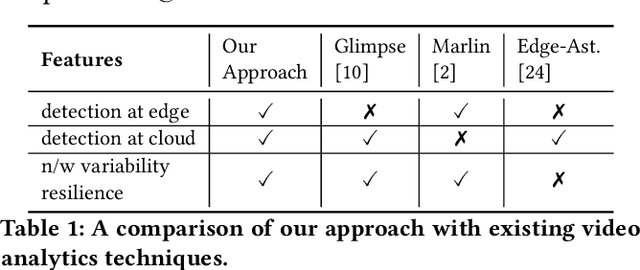
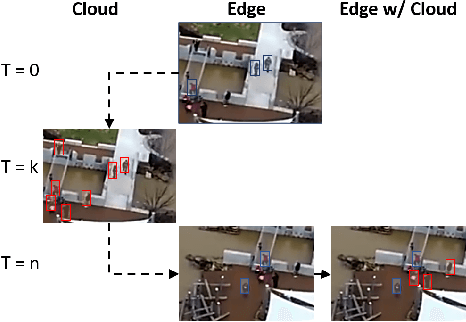

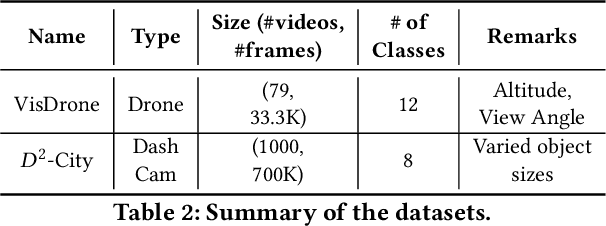
Abstract:Emerging Internet of Things (IoT) and mobile computing applications are expected to support latency-sensitive deep neural network (DNN) workloads. To realize this vision, the Internet is evolving towards an edge-computing architecture, where computing infrastructure is located closer to the end device to help achieve low latency. However, edge computing may have limited resources compared to cloud environments and thus, cannot run large DNN models that often have high accuracy. In this work, we develop REACT, a framework that leverages cloud resources to execute large DNN models with higher accuracy to improve the accuracy of models running on edge devices. To do so, we propose a novel edge-cloud fusion algorithm that fuses edge and cloud predictions, achieving low latency and high accuracy. We extensively evaluate our approach and show that our approach can significantly improve the accuracy compared to baseline approaches. We focus specifically on object detection in videos (applicable in many video analytics scenarios) and show that the fused edge-cloud predictions can outperform the accuracy of edge-only and cloud-only scenarios by as much as 50%. We also show that REACT can achieve good performance across tradeoff points by choosing a wide range of system parameters to satisfy use-case specific constraints, such as limited network bandwidth or GPU cycles.
WattScale: A Data-driven Approach for Energy Efficiency Analytics of Buildings at Scale
Jul 02, 2020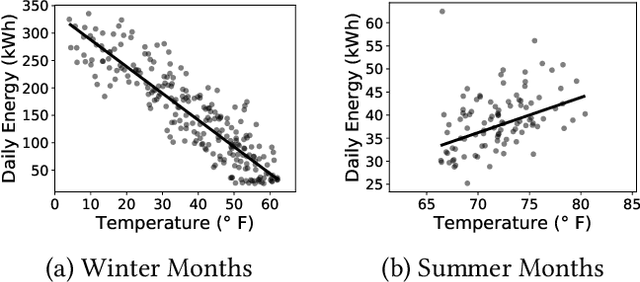

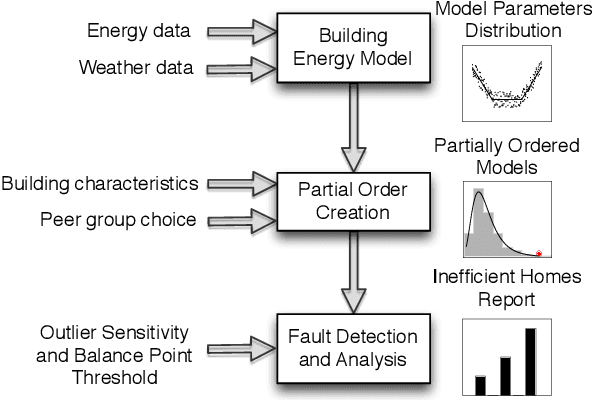

Abstract:Buildings consume over 40% of the total energy in modern societies, and improving their energy efficiency can significantly reduce our energy footprint. In this paper, we present \texttt{WattScale}, a data-driven approach to identify the least energy-efficient buildings from a large population of buildings in a city or a region. Unlike previous methods such as least-squares that use point estimates, \texttt{WattScale} uses Bayesian inference to capture the stochasticity in the daily energy usage by estimating the distribution of parameters that affect a building. Further, it compares them with similar homes in a given population. \texttt{WattScale} also incorporates a fault detection algorithm to identify the underlying causes of energy inefficiency. We validate our approach using ground truth data from different geographical locations, which showcases its applicability in various settings. \texttt{WattScale} has two execution modes -- (i) individual, and (ii) region-based, which we highlight using two case studies. For the individual execution mode, we present results from a city containing >10,000 buildings and show that more than half of the buildings are inefficient in one way or another indicating a significant potential from energy improvement measures. Additionally, we provide probable cause of inefficiency and find that 41\%, 23.73\%, and 0.51\% homes have poor building envelope, heating, and cooling system faults, respectively. For the region-based execution mode, we show that \texttt{WattScale} can be extended to millions of homes in the US due to the recent availability of representative energy datasets.
 Add to Chrome
Add to Chrome Add to Firefox
Add to Firefox Add to Edge
Add to Edge